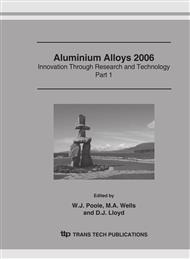[1]
K. Johnson, Advanced Materials and Processes 160, (2002) 62.
Google Scholar
[2]
U.S. Congress, 1975, http: /www. ita. doc. gov/td/auto/cafe. html; Accessed on: October 20, (2005).
Google Scholar
[3]
Life cycle inventory of the worldwide aluminium industry with regard to energy consumption and emissions of greenhouse gases. Part 1 - automotive; International Aluminium Institute, http: /www. world-aluminum. org/iai/publications/, (2000).
Google Scholar
[4]
M.P. Thomas and A.H. Wirtz, Resources, Conservation and Recycling 10, (1994) 193.
Google Scholar
[5]
G. Hoyle, Resources, Conservation and Recycling 15, (1995) 181.
Google Scholar
[6]
P. Koltun, A. Tharumarajah, and S. Ramakrishnan, In: N.R. Neelameggham, H.I. Kaplan and B.R. Powell (Ed. ) Magnesium Technology 2005, San Francisco, CA; TMS (The Minerals, Metals and Materials Society), Warrendale, 2005, 43.
Google Scholar
[7]
S. Ramakrishnan and P. Koltun, Resources, Conservation and Recycling 42, (2004) 49.
Google Scholar
[8]
M.F. Ashby, Acta Mater. 48, (2000) 359.
Google Scholar
[9]
M.F. Ashby, Materials selection in mechanical design (Butterworth-Heinemann, Oxford, 2005).
Google Scholar
[10]
P.M. Weaver, M.F. Ashby, S. Burgess, and N. Shibaike, Materials & Design 17, (1996) 11.
Google Scholar
[11]
W.S. Miller, L. Zhuang, J. Bottema, A.J. Wittebrood, P. De Smet, A. Haszler, and A. Vieregge, Mater. Sci. Eng. A 280, (2000) 37.
DOI: 10.1016/s0921-5093(99)00653-x
Google Scholar
[12]
Granta Design Ltd., CES Selector, 2005, http: /www. grantadesign. com.
Google Scholar
[13]
American Metal Market Daily, 2005, www. amm. com; Accessed on: June 14, (2005).
Google Scholar
[14]
D.A. Kramer, U.S. Geological Survey, 2005, http: /minerals. usgs. gov/minerals/pubs/commodity/magnesium/mgmis1q05. xls; Accessed on: June 23, (2005).
Google Scholar
[15]
L. Holloway, Mater. Design 19, (1998) 133.
Google Scholar
[16]
U.G.K. Wegst and M.F. Ashby, In: (Ed. ) The 3rd Bienal World Conf. on Integrated Design and Process Technnology (IDTP), Berlin, Germany; 1998, 88.
Google Scholar
[17]
C. Hunt, Australian Journal of Environmental Management, 2004, http: /colinhunt. zenburger. com/australiangreenhouse. html; Accessed on: June 28, (2005).
Google Scholar
[18]
C. Bae and N. Trumbul, Center for Climate Change and Environmental Forecasting, U.S. Department of Transportation, 2005, http: /courses. washington. edu/gmforum/topics/trans_climate/trans_climate. htm; Accessed on: June 15, (2005).
Google Scholar
[19]
P.A. Plunkert, U.S. Geological Survey, 2005, http: /www. usgs. gov/pubprod; Accessed on: October 20, (2005).
Google Scholar
[20]
D.A. Kramer, U.S. Geological Survey, 2004, http: /pubs. usgs. gov/circ/2004/1196am/; Accessed on: October 20, (2005).
Google Scholar
[21]
ODNR, Ohio Department of Natural Resources, 2005, http: /www. dnr. state. oh. us/recycling/awareness/facts/aluminum. htm; Accessed on: October 24, (2005).
Google Scholar
[22]
S.F. Sibley and W.C. Butterman, Resources, Conservation and Recycling 15, (1995) 259.
Google Scholar
[23]
S. Valtierra, Personal communication; svaltier@nemak. com, Nemak Pty., Monterrey, Mexico; (2005).
Google Scholar
[24]
G. Hanko and G. Macher, In: H.I. Kaplan (Ed. ) Magnesium Technology 2003, San Diego; TMS (The Minerals, Metals and Materials Society), Warrendale, 2003, 29.
Google Scholar
[25]
K. Buxmann, Resources, Conservation and Recycling 10, (1994) 17.
Google Scholar


